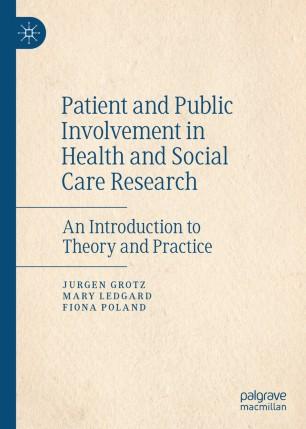Patient and Public Involvement in Health and Social Care Research: An Introduction to Theory and Practice 1st ed. Edition Jurgen Grotz
Visit to download the full and correct content document: https://ebookmass.com/product/patient-and-public-involvement-in-health-and-social-c are-research-an-introduction-to-theory-and-practice-1st-ed-edition-jurgen-grotz/





Patient and Public Involvement in Health and Social Care Research



An Introduction to Theory and Practice
jurgen grotz


mary ledgard
fiona poland





Patient and Public Involvement in Health and Social Care Research
Jurgen Grotz • Mary Ledgard
Fiona Poland
Patient and Public Involvement in Health and Social Care Research
An Introduction to Theory and Practice
Jurgen Grotz
Faculty of Medicine and Health Sciences
University of East Anglia
Norwich, UK
Fiona Poland
School of Health Sciences
University of East Anglia
Norwich, UK
Mary Ledgard
Norwich, UK
Jurgen Grotz and Fiona Poland’s involvement was supported by the National Institute of Health Research (NIHR) Applied Research Collaboration East of England (ARC EoE) programme. The views expressed are those of the authors, and not necessarily those of the NIHR, NHS or Department of Health and Social Care.
ISBN 978-3-030-55288-6
ISBN 978-3-030-55289-3 (eBook)
https://doi.org/10.1007/978-3-030-55289-3
© The Editor(s) (if applicable) and The Author(s), under exclusive licence to Springer Nature Switzerland AG 2020
This work is subject to copyright. All rights are solely and exclusively licensed by the Publisher, whether the whole or part of the material is concerned, specifcally the rights of translation, reprinting, reuse of illustrations, recitation, broadcasting, reproduction on microflms or in any other physical way, and transmission or information storage and retrieval, electronic adaptation, computer software, or by similar or dissimilar methodology now known or hereafter developed.
The use of general descriptive names, registered names, trademarks, service marks, etc. in this publication does not imply, even in the absence of a specifc statement, that such names are exempt from the relevant protective laws and regulations and therefore free for general use. The publisher, the authors, and the editors are safe to assume that the advice and information in this book are believed to be true and accurate at the date of publication. Neither the publisher nor the authors or the editors give a warranty, expressed or implied, with respect to the material contained herein or for any errors or omissions that may have been made. The publisher remains neutral with regard to jurisdictional claims in published maps and institutional affliations.
This Palgrave Macmillan imprint is published by the registered company Springer Nature Switzerland AG.
The registered company address is: Gewerbestrasse 11, 6330 Cham, Switzerland
We dedicate this book to those taking part in patient and public involvement, who don’t give up, who continue to try and who manage to also bring joy and love to doing it, often in diffcult circumstances.
Preface
Before you go on to read the rest of this book, do ask yourself: “Is this book right for me?” We want to start now by explaining how you can fnd out.
This is a book about people coming together, involving patients and members of the public well, often in diffcult circumstances, to make sure that health and social care research achieves good and relevant outcomes. If you would like to be a part of this, our book can help you to translate your interest in patient and public involvement (PPI) into practice that is both meaningful and achievable.
Before you start exploring further, you should know that involving patients and the public may not mean that everyone agrees all of the time. It may seem obvious that people whose lives may be affected by the research should help shape that research. But whether and how such involvement happens can be contentious—and the arguments may need to be heard! Some people don’t welcome it at all, because they say it infringes academic freedom. Others say that only those who have lived experience are suitably qualifed and therefore should have a leading role, rather than a minor role or none at all. And some see PPI as an unnecessary but obligatory drain on resources of money and time that must be managed effciently to minimize disruption, bringing rules and regulations that make more bureaucracy rather than better PPI. Still others argue that disruption is a core function of PPI, so that rules and regulations are needed to support, not hinder it. Therefore, to take your PPI practice forward, you will need to recognise and address issues of diversity
and disparities in power, and to be prepared to challenge inappropriate bureaucratic constraints.
This book aims to share, and encourage you to go on to add to, what is now seen as important in PPI by providing a comprehensive overview of current theory and practice on patient and public involvement in research. Its seven chapters cover the historical and conceptual background shaping PPI; a variety of ways of putting it into practice; what ethical issues need to be considered and critical perspectives on PPI including its potentially negative impacts. It also offers a step-by-step guide to planning PPI, including approaches to meaningful evaluation. Drawing on current literature, this book provides an essential reference work for all who want to better understand PPI in research and involvement practice. It includes a glossary of terms essential to this work. Many of the examples and much of the guidance we refer to are drawn from the National Health Service (NHS) in the UK before the 1990s, when responsibilities for health services were devolved to Wales and Scotland as well as Northern Ireland. Subsequent references are more often made to the NHS in England. The NHS in both periods took many steps and pioneered substantial guidance to promote PPI which has often since been referred to or drawn on by other countries worldwide in developing their own PPI. While we have provided examples of these other countries’ activities and policies where possible, we have referred to NHS materials as they provide the currently most-cited, most comprehensive and most-reported and evaluated body of PPI activities and policies.
However, we cannot achieve meaningful involvement by reading a textbook alone. Our approach to PPI means moving away from ideas of ‘seeking to involve others’ or ‘being involved by others’ and towards ‘each of us being involved with everyone else’. This is about each of us taking personal responsibility for building the relationships that enable us to do so.
This presents us, the writers, with an awkward dilemma because this is, after all, a textbook. We have designed it for all people, including practitioners and researchers, who make inclusive involvement, in research happen, to do so competently. However, to make meaningful PPI happen we need not just to be competent in the practicalities of involvement, but also to be personally ready to commit to becoming involved and to take responsibility. Personal readiness can less easily be taught in a textbook as it relies on your own willingness to be or to become used to challenging and questioning yourself about what you
are doing and thinking. We will help you by providing scenarios you can explore and key questions you can ask yourselves.
We suggest that before you start reading the rest of this book, you look again at your motivations to involve or be involved. If you only open the book to quickly fnd some buzzwords to add to a funding application where the funder has asked you to explain your approach to patient and public involvement, or if you are at the end of a project but now need to show some evidence of such involvement, this book won’t help you very much.
We particularly encourage you to try and put yourselves in other people’s shoes. This should be simple for the researchers and practitioners, to think like patients or the public, because they have all at one time or another been patients and are likely to be so more often as they become older. If, however, you are someone who sees your health or life experiences as relevant and motivating you to become involved in research and want to use this book to understand more about what you are letting yourself in for, try to briefy put yourself in the researcher’s shoes. What do you think their needs and diffculties might be? If you are not ready to try to understand and to respect the perspectives of patients and the public, or to appreciate why researchers are researching, this book is not for you.
Finally, rather than ‘involving’ or ‘being involved by’, we present all those involved as being ‘involved with’. This is very different. The methods and tools presented in this book rely on you bringing your personal commitment to those you seek to be involved with. If you are not prepared to ensure that everybody’s time is spent wisely, to strictly avoid tokenism and to be committed to consistently preventing exclusion and promoting inclusion, this book will not ft your approach to practice.
This book will not offer you frm rules to tell you in advance what to do, nor will you be able to rely on this book to later say ‘but they told me to do it that way’ if something doesn’t work out. This book will instead encourage you to apply your knowledge to question how involvement is happening as it happens, to include questioning yourself and your own role so that you can make your own assessment of what to do, with some confdence in yourself. You will therefore need to be able to make these crucial assessments and to take personal responsibility for your actions in making involvement happen. This means knowing about your motivation, perspective and commitment as presented in Fig. 1.
Motivation

Ask yourself why you want to be involved and involve others.
Perspective
Be prepared to put yourself into the shoes of the people you want to be involved with.
Commitment
Consider how you are committed to respecting the personal contribution of the people you want to be involved with.
Indeed, before starting to become involved in PPI, you may also want to look at some comments of others, which are freely available on the internet. One example is Peter Beresford’s short video clip on ‘How not to do service user involvement’.
Having said all this, if you want to make PPI happen with meaning for all involved, we want to ensure that you can readily fnd plenty of evidencebased guidance in this book and importantly to also fnd enjoyment in the PPI process. It may not often be said, but if PPI is not at least a little bit enjoyable, people will not do it for long. PPI is about people being interested in coming together to learn and share lessons, in often diffcult circumstances. Conviviality and respect must therefore be the most basic ingredients.
Norwich, UK
Jurgen Grotz Mary Ledgard Fiona Poland
acknowledgements
We wish to thank all the many public, voluntary and community group members, the volunteers, health and social care professionals and researchers whose experiences and insights have inspired this work. While some of the conversations, dilemmas and ideas we are reporting are challenging, we have always found these to be instructive. We are now sharing some of what we have learned and hope this will lead to further discussion and new directions for collaborative research, and knowledge for inclusive involvement. We are also most grateful to our families and partners for their patience while we were writing this. We hope you will fnd it worthwhile and accessible.
about the authors
Jurgen Grotz PhD, is the Director of the Institute for Volunteering Research (IVR) at the University of East Anglia, in the Faculty of Medicine and Health Sciences and a research fellow with the NIHR Applied Research Collaboration (ARC) East of England Inclusive Involvement in Research for Practice-Led Health and Social Care Theme. He has co-edited the Palgrave Handbook of Volunteering, Civic Participation, and Nonproft Associations (2016).
Mary Ledgard Mary Ledgard’s professional background was in policy analysis focusing on international politics and economics from the EU to China and North Korea. She moved on to work on service improvement in the public sector. On retiring, she decided to use her skills to put something back, serving as a trustee of Healthwatch Norfolk which gives a voice to local people on health and social care services. Today she focuses on working with the public sector on issues concerning older people and carers and is a relentless advocate of involving them in developing the services they need to live well and independently.
Fiona Poland is Professor of Social Research Methodology, leading the Inclusion Research Theme in the School of Health Sciences at the University of East Anglia (UEA), is UEA Lead for Volunteering Research, and co-leads the NIHR ARC East of England Inclusive Involvement in Research for Practice-Led Health and Social Care Theme. She is journal editor of Quality in Ageing and Older Adults.
abbreviations
BMJ British Medical Journal
CHC Community Health Councils
GDPR General Data Protection Regulations
HRA Health Research Authority
NCVO National Council for Voluntary Organisations
NHMRC National Health and Medical Research Council (Australia)
NHS National Health Service
NIHR National Institute for Health Research
PPI Patient and Public Involvement
PPIRes Public and Patient Involvement in Research project
PPV Patient and Public Voice
RDS Research Design Service
REC Research Ethics Committee
UKRI UK Research and Innovation
UNCST Uganda National Council for Science and Technology
VCSE Voluntary, Community and Social Enterprise
VSSN Voluntary Sector Studies Network
WHO World Health Organisation
list of figures
list of tables
list of case examPles

CHAPTER 1
Introduction
Since at least the 1960s, disabled people, people living with challenging conditions, people living in disadvantaged neighbourhoods and members of groups seen as different, have highlighted that their needs for health and social care services cannot be well understood or evidenced unless they are involved in producing knowledge about the needs of their communities for use in research and for themselves. Involving patients and the public in health and social care research is therefore vital for providing services and research that can be recognised as relevant to and connected with people’s lives and wellbeing.
Respecting people as citizens who can play their part fully as members of society is a key moral issue. Denying access to health and social care services and to shaping those services constrains people’s ability to act for themselves and for others, and to be treated equitably. It is also now required by law in the UK, in many European countries, and on other continents.
Because people’s lives and needs are so different and because we are still fnding out about these by working and talking with each other, we cannot know what they are in advance of planning research. Nor can we decide in advance what are the best ways to build such involvement, particularly since being a patient and public involvement (PPI) representative must be a voluntary activity. This means that the most suitable approach is not something we automatically agree on. It is something where we can build on lessons from the different experiences of ourselves and others to date
© The Author(s) 2020
J. Grotz et al., Patient and Public Involvement in Health and Social Care Research
, https://doi.org/10.1007/978-3-030-55289-3_1
to work together to decide what kinds of voluntary patient and public involvement may be useful to each of us to apply and to develop. We are therefore writing this book, drawing on our different experiences of supporting patient and public involvement in research, as volunteers and researchers, so as to provide some defnitions of what it is, reasons why it should be done, how it can be done and what resources can help us to do it well.
A clear and compelling challenge we must address is how to ensure that we comprehensively involve the range of different individuals and groups we need, while they are also acting as volunteers. This means that PPI must be inclusive and be shown to be inclusive. Again, we cannot assume in advance that we know how to work inclusively until researchers and community members are talking, sharing and revising their views.
This book is therefore designed to help readers to fnd their own way, to make their own decisions about and to take responsibility for identifying what is important and useful for supporting PPI that works for them, in order to produce good evidence for designing health and social care and to guide collaborative and voluntary relationships to achieve this. In this way, you can recognise your responsibilities and means of being responsible for good PPI practice in the research you are contributing to.
It is important to remember that research into health and social care covers a number of very different types of health topics, groups and places, ranging from medicines and hospital treatment to care provision for those living with long-term conditions and the public health of particular communities. Research within each of these areas will need to take account of different cultures and practices of people working in and using them. PPI that can bring useful insights in each case will mean taking additional account of the kinds of PPI needed, the different skills it will call for, and what this will mean for engaging with and supporting PPI.
In this chapter, we start by setting out the basics you should know to get started in supporting or actively developing the involvement of patients and the public in research, whether as a PPI representative, a researcher or a member of a group commissioning research. At the end of this chapter, you should know how to defne for yourself what patient and public involvement is, how it is talked about, the reasons for doing it, and what roles it can play in research. This will include appreciating different viewpoints about this role and what means people have to express their viewpoints on becoming involved in research. It will be clear by now that our approach should also equip you to question PPI guidance that seems to
assume widespread consensus about the issues involved. If such guidance exists, it is unlikely to have recognised the different experiences and views of groups that need to be involved. Assuming rather than building such consensus can bury diverse points of view or close off ways of expressing them. To work inclusively therefore means that you will need also to take responsibility for being continuously open to the possibility that other people’s views and the ways they express them may be different from your own or what you have experienced so far.
We will now look more closely at questions to help us work out key features shaping PPI in our own situation and more widely:
• What are the personal and research reasons for doing PPI?
• What terminology—words and their meanings—can we agree for PPI?
• Why should we see PPI in research as volunteering?
• Where is PPI being done in research activities?
• How can PPI increase the power of patients and the public to shape research?
1.1
What are the Personal and research reasons for doing PPi?
Supporting PPI cannot be a tick box exercise existing only as words on paper rather than as shared understandings and actions in practice. We need to identify appropriate reasons for supporting it. We need to understand how to ensure that these reasons are embodied in the activities we personally undertake, and why we want to and should involve people in shaping it. Exercise 1.1 gives you a chance to think about a working example.
Exercise 1.1
You are setting up a new project to find out how to improve community services for disabled people. Why may you want patient and public representatives to be involved in the project?
In carrying out this exercise you may want to think about how disabled people think, and can be thought about, as members of the community in question, and who can bring relevant information to shape and give access to community services that include the groups involved.
Whether PPI happens will depend on the reasons why we think it should be done. There are at least fve types of argument for supporting PPI within health and social care research:
• The theory-based (epistemological) argument—who can know best?
• The methodological argument—how do we gain more accurate and relevant knowledge to achieve better results from research?
• The moral argument—what are the democratic and ethical reasons for doing PPI?
• Funder requirements
• Legal requirements—what do laws tell us our own and others’ responsibilities are in doing PPI?
The theory-based (epistemological) argument—who can know best?
One of the most compelling arguments for involving patients and the public is that they are especially well-placed to develop and share relevant knowledge of what is needed and what does or does not work. This is often based on their experience as service users. Service user is both a descriptive and a political term. Some researchers suggest that only a ‘signifcant minority’ would like to be referred to as service users (Simmons et al. 2010). Peter Beresford is a mental health service user and researcher who has tested out and campaigned for these arguments with service users and organisations for many years. He has published ‘A Short Theory of Knowledge Distance and Experience’ for the service user organisation ‘Shaping Our Lives’. Beresford argues that we must value ‘experiential knowledge’ rather than simply dismiss it as ‘non-scientifc’, because knowledge created without the insights available from evidence based on experience is fundamentally fawed.
The greater the distance between direct experience and its interpretation, then the more likely resulting knowledge is to be inaccurate, unreliable and distorted. (Beresford 2003: 4)
However, such an argument directly challenges the values of academic scientifc methods of evidence-building which mainly prioritise remaining neutral and objective, and keeping a distance between researchers, research and those whose lives may be affected by research fndings on a topic. The involvement in research of a person with a close interest in its results may be seen as being likely to lead to biased results, so many academics may
resist mixing research to build unbiased evidence and ‘interested’ experience. We will revisit how these issues may be dealt with in supporting and developing PPI, translating them into real-life motives and decisionmaking in the sections and chapters that follow, including those on research ethics.
The methodological argument—how do we gain more accurate knowledge to achieve better results from research?
While we may not agree on whether individual groups will have more or less relevant or unbiased experience to shape knowledge, we may agree that some people will have more accurate and detailed knowledge of living with conditions and support services to help us fne-tune what we already know and to design services that take this into account. Patients can offer insights and stories which are based on their direct experience of a particular condition, and taking these views into account will improve the focus and quality of the research and increase its connections with people’s lives. Such connections may be strengthened if some of the evidence is gained through collaborations with peer researchers. The National Institute for Health Research (NIHR) Research Design Service (RDS) which supports health and social care researchers across England, for example, offers this advice.
The contributions of patients can be extremely valuable, providing alternative views from those of the research team or NHS staff. Patients are able to make judgements based on their understanding of their condition and may have different aspirations and thoughts about health outcomes that health care professionals and researchers may not have considered. (NIHR RDS 2014: 6)
This is different to the epistemological argument above as it simply suggests that the work that researchers do should be informed by the details of people’s experience including their concerns, culture, language and education. This kind of detailed knowledge can be brought by PPI representatives to help make patient leafets easier for non-researchers to read and understand, or to explain where to locate and build collaborative relationships between researchers and other groups of people who may take part in the research or want to know about the research fndings and its likely effects. The morality and ethics involved in research, which comes from involving people, can be a part of the methodological argument.
The moral argument—what are the democratic and ethical reasons for doing PPI?
Research aiming to produce fndings which affect people’s lives cannot make a difference unless it has public support; and it will not gain that support if it cannot be shown to be relevant and benefcial rather than harmful to those affected during or through the research. Where such research aims to evidence the specifc usefulness of health and social care services which are publicly funded or publicly regulated, we need to ensure there is democratic agreement on what topics and methods are most important and relevant. Undertaking PPI provides a way to build democratic participation and agreement in shaping public services and evidence, and to demonstrate that this level of involved participation is being actively promoted. This can be seen increasingly in the statements of formal principles, policies and procedures developed by research funders, service providers, commissioners and other public and private organisations involved in the UK and in other countries.
We can see an example of a national policy following such principles in the National Health Service (NHS) Constitution for England (2015) which opens with the sentence “The NHS belongs to the people”. As the NHS is publicly owned, it is widely acknowledged that the public will demand forms of democratic participation so as to actively shape it and patient and public involvement is seen as an important form of such participation; such involvement can be seen to be central to planning, informing and decision-making.
You have the right to be involved, directly or through representatives, in the planning of healthcare services commissioned by NHS bodies, the development and consideration of proposals for changes in the way those services are provided, and in decisions to be made affecting the operation of those services. (NHS 2015: 9)
It is fair to say that such a democratic approach is not yet embedded in how the NHS or social care services work on a day-to-day basis. This is complicated further in countries with devolved sovereignty such as the UK where, for instance, there is now not only an NHS for England but also for separately governed health services in Wales, Scotland and Northern Ireland. Although there are now many more examples than there used to be from primary care patient participation groups to carer support groups, there is still a long way to go. NHS and social care leaders may not always provide wholehearted organisational support to the policy, nor can patients and the public easily access the time, resources and
incentives to participate. For example, a substantial part of the problem is that more often than not involvement activities take place in working hours. For PPI to happen more routinely, people will need to see that their involvement will actually make a difference. To achieve this, good practice in PPI is essential as we will fnd out in the coming chapters.
The importance of PPI in ensuring research is both relevant and also ethical is widely acknowledged by many of the key research funders in health and social care who now explicitly require PPI in the projects or programmes they fund. Ethics is about ensuring that people taking part in research or affected by its fndings are well-informed about any potential harms or benefts and can give voluntary consent to take part. PPI can help provide the understanding of people’s culture, language and education needed to ensure these ethical principles are applied for different places and communities. This is discussed in more detail in Chap. 5.
The legal requirements—what do laws tell us our own and others’ responsibilities are in doing PPI?
A wide range of legal duties must be observed by anyone involved in carrying out research, including PPI representatives contributing to research, but also research teams working with PPI representatives. These include observing any laws that apply worldwide to securely handling confdential data and the personal details of anyone connected with the research (in the UK, this is covered by the Data Protection Act (2018)), and any government policies relating to safeguarding vulnerable participants, such as in genetics or the rights to equality and diversity of specifc groups. Laws apply to standards in research such as preventing fraud, breaking into others’ information systems or gaining information through coercion. There are legal rights governing intellectual property involved in research designs and the products of research. Legal restrictions have also been set preventing research on some types of topic. Where PPI members of research teams are involved in taking responsibilities for aspects of research planning, activities or management, they will need to follow the same legal duties as anyone else involved in delivering the research and will need to be equipped to know what these are and also what is involved in meeting them.
In England, the Health and Social Care Act (2012) placed legally binding duties on the NHS and on clinical commissioning groups to “make arrangements to secure that individuals to whom the services are being or may be provided are involved (whether by being consulted or provided with information or in other ways)” (Paragraph 13Q: 22). This Act required
every higher-level local authority to set up a Health and Well-Being Board. The aim is to build partnership working between all key stakeholders to improve the commissioning and delivery of services across the NHS and local government. The local Healthwatch, a statutory organisation that provides the consumer voice of the local population, is a member by right. These boards may involve patients and the public in various ways such as through consultations or by setting up working groups which may include voluntary sector representatives to ensure that local communities shape local health and social care services, or regional public health networks.
These duties appear to extend to the Health Research Authority (HRA), which is also linked to the Department of Health but without corresponding statutory duties. However, as with all UK health organisations, the HRA has confrmed its commitment to an environment providing PPI opportunities within the UK policy framework for health and social care research, including “to get involved in its design, management, conduct and dissemination, and are confdent about doing so” (Health Research Authority 2017a: 4).
While we can expect these duties to extend to the NIHR, in England, this is not explicitly stated. The NIHR is one of the signifcant funders of research in health and social care. It is mostly funded by the Department of Health and Social Care and distributes those funds mainly through working directly with the NHS and universities.
The legal requirements for involving individuals and groups extend to involving people in their own health and social care. This also includes being involved in commissioning such services, and specifc guidance is available for commissioning organisations.
Professional standards run parallel to legal requirements and are covered in Chap. 5
Key Questions 1.1
What are your personal reasons for involving patients and the public in your current work in research?
What other reasons may there be for involving patients and the public in your current work in research?
1.2
What terminology—Words and their meanings can We agree for PPi?
If we want to identify, understand and collaborate on PPI, we need to know what words will help us do this. Unfortunately, we don’t all agree! Individual words may be used to refer to very different things, especially when we may be bringing together different experience and motivations to getting involved. Or we may well use different words when we are talking about the same things in practice. So if we are to work well together in PPI, we need to be aware of this to avoid misunderstandings.
We will now have a look at some of the key terms currently used. You will by now recognise that there cannot be general standardised agreement on what each one means and that you will have to clarify which ones people are using in different contexts and how they are using them. Particularly important here are the terms ‘involvement’, ‘engagement’ and ‘participation’; again there can be no authoritative or lasting way to defne these in a way that applies in every context. The recently developed NHS Patient and Public Participation Policy (2017b) is expressed in ways that can be tailored to different groups and contexts:
Participation (sometimes referred to as engagement or involvement) can take place in a variety of ways, for example through social media, voluntary community and social enterprise (VCSE) organisations, elected representatives, formal consultations and meetings. NHS England is committed to taking an approach that is appropriate to the situation and the needs of the people it is seeking to engage. (NHS England 2017b: 6)
The UK National Institute for Health Research funded organisation INVOLVE established in 1996, and not to be confused with a UK public participation charity ‘Involve’ established in 2003, is one of still only a very few government-funded bodies in the world to bring together PPI experience and insights to promote it as vital to research priorities, processes and products. This organisation makes a distinction between the three terms, allocating a more specifc meaning to each. They defne ‘involvement’ as where members of the public are active in research projects and organisations and offer as examples:
• as joint grant holders or co-applicants on a research project
• identifying research priorities
• as members of a project advisory or steering group
• commenting and developing patient information leafets or other research materials
• undertaking interviews with research participants
• user and/or carer researchers carrying out the research. (NIHR INVOLVE 2012: 7)
How quickly these terms and defnitions may change is illustrated by an announcement by the National Institute for Health Research (NIHR) that from April 2020 the ‘NIHR centre for patient and public involvement, engagement & participation and research dissemination’ would be hosted by a private company, LGC Limited, which, as the centre’s name suggests, will be co-ordinating and defning key components of PPI.
Exercise 1.2 provides an example where you can consider whether you can use the NIHR INVOLVE defnitions of involvement to decide whether this is an example of a group that is involved in shaping research.
Exercise 1.2
You have invited members of a patient support group for people with arthritis to discuss your research proposal to examine the effects of falls on their lives. How are they being involved in this research?
‘Participation’, for INVOLVE, is concerned exclusively with people being recruited as research subjects in clinical trials or social research, for example to complete research questionnaires. In contrast, ‘engagement’, for INVOLVE, concerns disseminating academic information through activities such as science festivals and general awareness raising about academic work.
It is worth noting that INVOLVE includes the dissemination of study fndings to research participants in its defnition of ‘engagement’, while often describing this dissemination elsewhere as an integral part of ‘involvement’ (NIHR INVOLVE 2012). This example highlights how defnitions are used in varying ways even by the organisation working most closely with PPI members and how such defnitions cannot remain fxed. The way these terms are used in the context of groups being involved in research at different times and for different purposes will remain inconsistent and very likely to change over time.
Unfortunately, the confusion does not become much clearer when we go on to look at the terms used to describe people who are involved. Are they ‘service users’, ‘lay representatives’, ‘lay voices’, ‘public voice representatives’, ‘patient and public involvement (PPI) representatives’, ‘experts by experience’ or ‘stakeholders’? NHS England again applies these fexibly:
Patient and Public Voice (PPV) Partners – ‘people who are willing to share their perspective and experience with NHS England to inform health services in a range of different ways’ – in its work. PPV Partners include patients, service users, carers, families and other members of the public. PPV Partners may also be referred to as people participating in ‘service user involvement’, ‘lay representatives’, ‘lay voices’, ‘public voice representatives’ or ‘patient and public involvement (PPI) representatives’. (NHS England 2017a: 4)
This may suggest to us that a way to start deciding how to fnd and use appropriate language would be to discuss and agree with people being involved in a particular piece of research how they would like to be described. This may sometimes mean referring to their role, for example lay representative; in other cases, it may be referring to the contribution they plan to make. Clarity and transparency of intentions need to be refected in the terminology you use from the outset. We will revisit this issue in more detail in later chapters.
The central concern of this book is of course ‘Patient and Public Involvement in Research’, so for the moment, we will proceed by providing an outline of some key terms we, the authors, aim to use in particular ways, explaining more about our reasons for suggesting these over the chapters that follow. We will take care to beware of terms which may suggest people are involved and shaping decisions, but which, if we are using them accurately, mean people are merely being informed about or are watching other people take decisions.
Patient and Public
A starting point for defning patients and the public is to ask the question who they may be. Most current descriptions are as inclusive as possible, recognising that virtually everybody will be a patient at some time.
The term ‘patients and the public’ includes everyone who uses services or may do so in the future, including carers and families. People who use health and care services may be referred to as ‘experts by experience’. (Patient and Public Participation Policy, NHS England 2017b: 6)
Thus, the term seems to imply that it includes both those who carry out research, or involve others, and those who are involved. When we use the term in this book we too want to be comprehensive, but to go one step further by recognising that all those who set out to involve will also be and have experience as patients and members of the public and so will have their own insights from that perspective. That raises the question: is there a key distinction between those involving and those being involved? Some guidance suggests that those being involved have no professional role in the context where involvement is being developed and applied, offering a distinction between researchers in health and social care and health and care professionals on the one hand, and on the other, patients, carers and other community-based partners. However, such a distinction raises several problems. For example, we know of academics with health conditions who have been invited on panels as PPI representatives because of their condition; yet they clearly also have professional experience which they cannot simply leave behind at the door. Another example is people who represent voluntary and charitable organisations; they may be paid staff, trustees or volunteers, and they may again bring professional expertise. The NHS England guidance recognises that when working with representatives of other organisations, especially from small, user-led organisations, researchers may need to support them if they are otherwise unable to take part (NHS England 2017a, 11). So, ‘patient and public’ is potentially everybody, and we should be cautious about starting with too rigid a defnition of what we need, but decide what is appropriate, respectful and inclusive when involving people in such research. This raises an important question especially in relation to those marginalised groups who want to speak for themselves. We will address this question in Chap. 5.
Involvement
Involvement is when patients and the public move from being unquestioning recipients of services to being involved citizens, not just in decisions about their own care but in the planning and delivery of care for all. Of course, there are many forms of involvement and we need to be conscientious in describing the context and purpose of any particular instance of involvement if we are to understand and fully share what we really mean. It is simply not good enough to refer to the word involvement and leave it at that.
Like NHS England, we view all PPI representatives in health and social care as volunteers. This raises important questions, for example, about
payments which, according to a defnition from the United Nations International Year of the Volunteer, are not completely excluded: “…the activity should not be undertaken primarily for fnancial reward, although the reimbursement of expenses and some token payment may be allowed…” (as quoted in Ellis Paine et al. 2010: 9) We will deal with these questions in Sect. 1.3.
We also argue that involvement applies ‘in both directions’. By this we mean that involvement does not rely on a formal invitation but may be on the initiative of an individual patient or member of the public. Involvement can be about taking an active part in shaping health and social care as a volunteer of a local Healthwatch or of a community organization overseeing care services. It can also be as a volunteer on a hospital ward or in a hospice, having freely chosen to actively provide services for others and by doing so changing and monitoring those very services.
Patient and Public Involvement
This term is currently widely used but is also changing. It does not seem to have a frmly agreed defnition, and needs to be tailored to and agreed in different contexts. It does not by itself guarantee a focus on involvement that is inclusive. When we use the term in this book we refer to the process of patients and the public moving from being unquestioning recipients of services to involved citizens not just in decisions about their own care but in the planning and delivery of care for all.
Patient and Public Involvement in Research
NIHR uses the following very broad defnition: “research being carried out ‘with’ or ‘by’ members of the public rather than ‘to’, ‘about’ or ‘for’ them” (NIHR INVOLVE 2012: 6). When we use the term in this book, it fows from the way we use Patient and Public Involvement. Thus, Patient and Public Involvement in Research is when people move from being unquestioning subjects of research to being involved members of a group which undertakes research; patients and the public are involved in this group in a voluntary capacity to improve the created knowledge and strengthen the methodology. In such research patients and the public will have physical, psychological and communication access to all relevant aspects of research and the respective roles, and the research meets legal requirements and professional standards.
Key Questions 1.2
Who should define what the terms mean?
What world-view is expressed by the definitions? Think particularly about the terms ‘service user’, ‘expert by experience’ and ‘PPI representative’.
1.3
Why should We see PPi in research as Volunteering?
Perhaps this question is not one you expected. You may ask what volunteering has got to do with PPI.
Firstly, it important to note that offcial UK health service guidance, both for the NHS services and the Health Research Authority, refers to those involved in PPI as volunteers. A Health Research Authority annual report (2017b) refers to “1,000 or so volunteers who serve on the RECs [Research Ethics Committees], the National Research Ethics Advisors’ Panel (NREAP), the Public and Patient Involvement Panel … who give their time freely to support the HRA and our work” (ibid: 5) and in a later report, volunteers are also described as “part of our patient and public involvement network” (Health Research Authority 2019: 6).
The NHS guidance on volunteer recruitment includes as specifc examples of volunteer roles in NHS provider organisations “expert patients” and “GP patient participation group” (NHS England 2017c: 5).
We also know that PPI is recognised as relevant in all aspects of health and social care, from commissioning to service improvements, from oversight to governance. Widely known examples of involvement activities in the UK health services organisations are: in Healthwatch England and local Healthwatch organisations where members of local communities seek information relevant to them and provide feedback on their health experiences; in clinical commissioning group where they are consulted; as volunteers in the work of NHS organisations and charities; and through NIHR INVOLVE, the body offcially funded to promote PPI.
Examples of PPI roles include:
Role 1: People choose to respond or comment on open access engagement opportunities, for example responding to online surveys. Expenses Category A (no fnancial support from NHS England). No expenses can be claimed.
Role 2: PPV Partner is invited to attend workshops / events / focus groups on a ‘one off’ basis. Expenses Category B (out-of-pocket expenses are covered or reimbursed).
Role 3: PPV Partner is a member of regular working group meetings. Expenses Category B (out-of-pocket expenses are covered or reimbursed).
Role 4: PPV partners are in senior PPV Expert Advisor roles that demonstrate strategic and accountable leadership and decision making activity. Expenses Category C (out-of-pocket expenses are covered or reimbursed AND an involvement payment is offered). (NHS England 2017a: 8)
For example, in its Annual Report 2016–17, Healthwatch England thanks its 4700 volunteers who “gave up their time to support our work” (Healthwatch 2017).
Importantly, all these roles are voluntary: unpaid and freely chosen. So here, NHS England insists in its guidance that even those involved in ‘Expert Advisor’ roles are ‘volunteers and not employees’, despite this same guidance emphasising that senior ‘Expert Advisors’ should be paid ‘at least equal to the National Minimum Wage’. Rates for ‘involvement payments’ are currently set at £150 per day/meeting or £75 per half day. Ensuring this is a volunteer role is vital if people undertaking it are going to be seen to make independent contributions which take into account or seek to represent the views and interests of other groups of people beyond services or policymakers.
NHS England provides detailed guidance on how its approximately three million volunteers (NHS England 2017c) can contribute and be respectfully and safely supported. The need for this was reinforced by the Lampard Inquiry which investigated matters relating to the widespread abuse by Jimmy Saville through his volunteer access to service users, staff, services and information.
However, what links NHS guidance on volunteer involvement to the practice of public involvement in general and in health and social care research in particular is often less clear. At times, what happens can seem to directly contradict the NHS’s own standards of involvement and its stated ambition. For example, the NIHR Standards of Involvement aim to provide “clear, concise benchmarks for effective public involvement alongside indicators against which improvement can be monitored” (NIHR 2018: 2). However, while they are described as being based on results from a public consultation, they remain vague. They do not clearly refect strongly argued and evidenced concepts and values which can build trust, for
